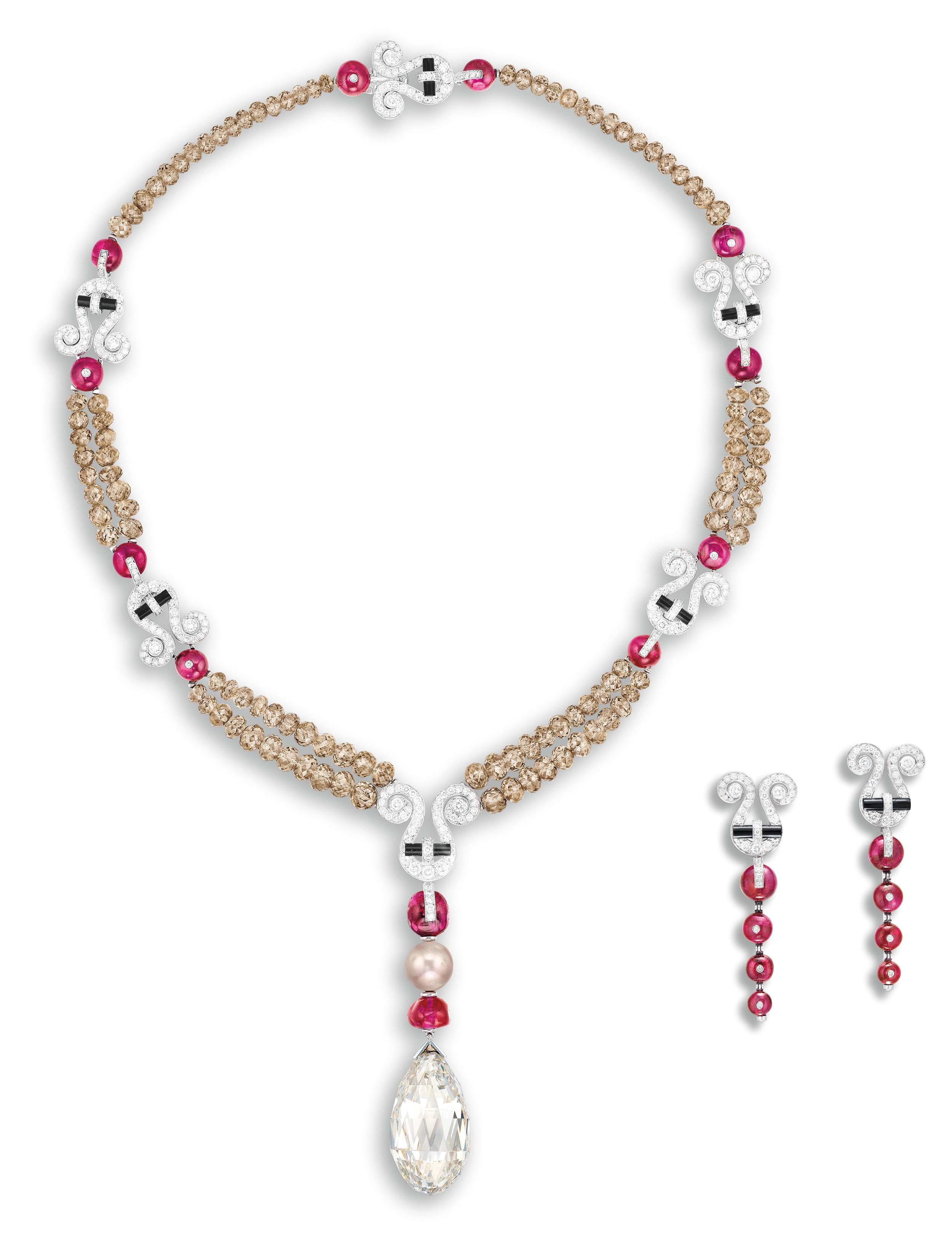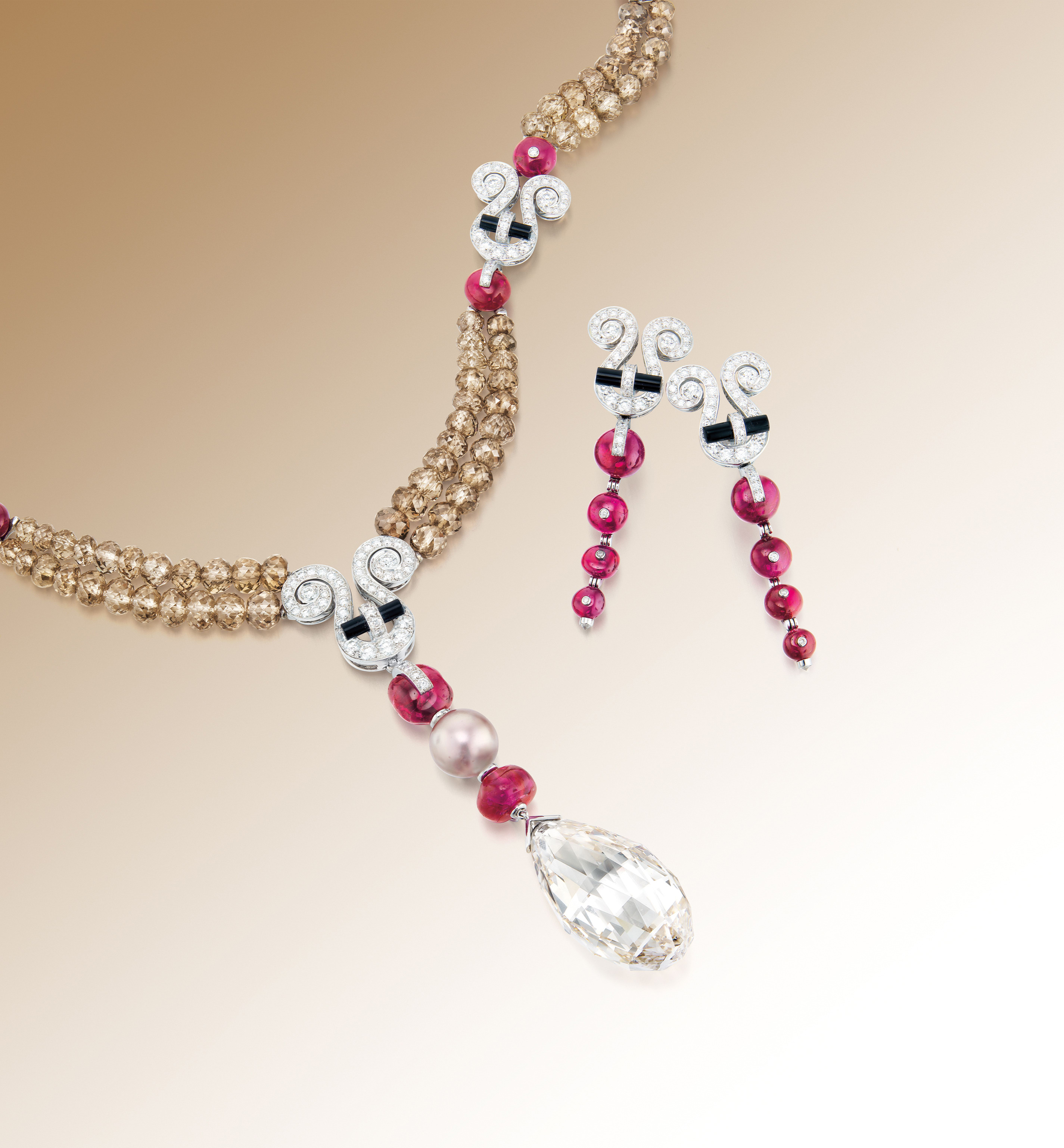





637
Cartier
A Unique and Spectacular Diamond and Gem-set 'Jambi' Necklace and a Pair of Matching Pendent Earrings, Cartier
Full-Cataloguing
Briolette is believed to be one of the oldest diamond cuttings that originated from India approximate 800 years ago. It is defined as is a pear- or drop-shaped diamond that is covered with triangular facets in its entire surface, allowing light to enter and be refracted from all sides, maximizing light return to the eye and lending it a brilliance unseen in other diamonds cuttings. That being said, the colour and brilliance of a briolette is never glaring, they are appreciated throughout history for their soft refined elegance.
Briolette diamonds are often associated with antique and estate jewels since they were highly popular during the 17th century, however, later in that century they gave way to early versions of modern day round brilliant cut. Their popularity resurged again during the Victorian period through Art Deco years but was quick to decline due to high cost and large mass of rough required for fashioning. These are also the reasons why antique briolette diamonds are very rare in today’s market since most of them had been recut to other shapes.
It is also worth noting that no two briolettes are exactly the same, and they are generally unencumbered by any setting except at the top, often suspended as a pendant on necklaces or earrings from the drilled channel. Aside from the infamous necklace displayed in the Smithsonian Institution which was presented by Napoleon to Empress Marie Louise containing 10 briolette diamonds, the Briolette of India that weighs 90.38 carats counts among some of the world’s most mesmerizing briolette diamonds of historical importance.
Cartier and Exoticism: Past and Present
Jambi, after which this demi-parure is named, is a province in modern day Sumatra, Indonesia. Strategically located, it was one of the two major centres of Srivijaya empire that flourished commercially between the 7th and the 13th centuries. During the golden age of Srivijaya, it was arguably one of the largest empire in the East, stretching from Suratthani in Thailand to West Java, gaining control two key and significant traits, namely the Malacca strait and Sunda strait. Their maritime power was the reason the Srivijaya Kingdom achieved commercial dominance and acquired wealth and riches that equalled those of Maharajas in India at that time. The Cartier brothers, collectors of antiquities and enlightened travellers, were fascinated by culture and arts from the Far East, which consequently exerted an influence on the maison’s creations. In 1913, Cartier presented a collection of fifty oriental jewels in their New York salon which marked the beginning of a remarkable stylistic journey. Everything from necklaces and tiaras, to vanity cases and clocks drew inspiration from foreign motifs, yet Cartier’s designers rarely rendered foreign traditions literally in their works, they often combined various patterns and forms that lent them aesthetic vigour and exotic flair. These unique creations have since become the most highly desired masterpieces by collectors worldwide.
Reference to Oriental jewels is evident in this ‘Jambi’ demi-parure in the use of ruby beads and rose-cut diamond beads, exuding opulence of Maharajas who entrusted Cartier with their precious gemstones and diamonds during many visits Jacques Cartier made to India in early 20th century. India had always had its own approach to stone-cutting; emeralds and rubies were fluted and engraved, diamonds employed rose cut or are fashioned into briolette. The irregular shapes and unrefined lines were adored by Cartier as a poetic expression of natural elegance. In 1991 and 2007, Cartier presented La Route des Indes and Inde Mysterieuse high jewellery collection respectively, paying homage to this celebrated theme. On this Jambi necklace, the structured outline of the diamond-set harp motif is balanced by the erratic shapes of the ruby and rose-cut diamond beads. These elements are then anchored by an impressive briolette in a soft golden tone and subtle scintillation --- a daring combination of stylistic influences and a triumphant meeting of East and West.
Cartier
FrenchWith the Constitution of 1848 came a new standard for luxury in France. Founded one year prior by Louis-Francois Cartier, the house of Cartier was one of the first to use platinum in jewelry making. This incredibly expensive material became the stepping-stone for Cartier to experiment in form, mechanisms and attitude. It helped men move from pocket watches to wristwatches, effectively making the watch much more functional and prominent in a man's overall wardrobe.
Cartier did not only touch on functionality. Inspired by a commissioned painting by George Barbier featuring a black panther at the feet of an elegantly bejeweled woman, Cartier began incorporating wild animals in his designs—most notably, Cartier Panthère rings, bangle bracelets and watches. Yet it wasn't until the late 1960s that the house of Cartier debuted their iconic yellow and rose gold LOVE collection, which includes the famous bracelet that only a special screwdriver can open.